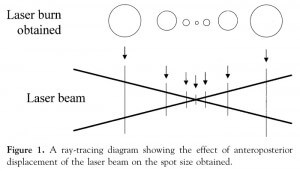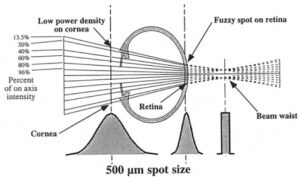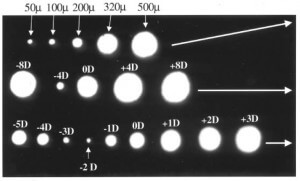Blumenthal EZ, Serpetopoulos CN.
Ophthalmology. 2000 Feb;107(2):329-33.
Department of Ophthalmology, Hadassah University Hospital, and Hebrew University-Hadassah Medical School, Jerusalem, Israel.
ABSTRACT:
PURPOSE: Meaningful errors in photocoagulation spot size may result from several factors. In this article we discuss one major factor, namely, fluctuations in the surgeon’s accommodative state, coupled with an inaccurate setting of the slit-lamp oculars.
DESIGN: Experimental study.
METHODS: We analyzed and tested the optics of slit-lamp mounted lasers. Varying the ocular setting is correlated with measurements of the actual spot size obtained with each system.
MAIN OUTCOME MEASURE: The spot size obtained.
RESULTS: Three distinct, but related, phenomena that may lead to spot size errors are defined: (1) focusing the laser spot as opposed to focusing the retinal image; (2) instrument misalignment; (3) inadvertent accommodation.
CONCLUSION: The ocular setting must be meticulously calibrated to produce a true spot-sized burn. At the 50 microm setting, each diopter of induced accommodation, or erroneous ocular setting, almost doubles the actual spot size obtained. With large (500 microm) spot size settings, the defocused delivery system is more prone to spot-size errors in contrast with parfocal lasers.
Figures from this article:







